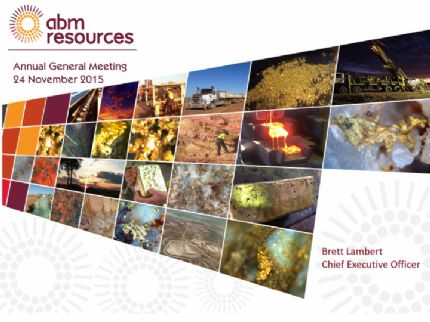 ABM Resources NL (ASX:ABU) Announce High Grade Gold Results from Old Pirate Bulk Sampling and Trenching Program Phase 2a
ABM Resources NL (ASX:ABU) Announce High Grade Gold Results from Old Pirate Bulk Sampling and Trenching Program Phase 2a
Perth, Nov 29, 2011 AEST (ABN Newswire) - ABM Resources NL ( ASX:ABU) is pleased to announce results from Phase 2a (116 samples) of the systematic Old Pirate Bulk Sampling and Trenching Program, which is part of the Company's Twin Bonanza Gold Camp Project.
ASX:ABU) is pleased to announce results from Phase 2a (116 samples) of the systematic Old Pirate Bulk Sampling and Trenching Program, which is part of the Company's Twin Bonanza Gold Camp Project.
- Phase 2a results averaging 28.34g/t gold over a combined vein strike length of 110 metres (116 samples).
- Combined Phase 1 / Phase 2a show overall updated results of:
1,188kg of surface vein material sampled from combined strike length total:
282 metres strike length averaging 22.45g/t gold.
Individual higher grade vein strike lengths with combined Phase 1 / Phase 2a results include:
83 metres strike length averaging 56.31g/t gold
30 metres strike length averaging 26.58g/t gold
10 metres strike length averaging 78.28g/t gold.
- Phase 2a peak assay of 344g/t gold.
- 29 samples (out of 116 Phase 2a samples) graded greater than 10g/t gold averaging 111.01g/t gold).
- 12 samples (out of 116 Phase 2a samples) graded greater than 100g/t gold averaging 219.08g/t gold.
- Individual veins exposed range from 40cm to 5 metres in width (averaging 1.2 metres).
- Further samples from Phase 2 and Phase 3 of the bulk trenching (for a further 1,028 samples) are currently being assayed and will be presented shortly.
Darren Holden, Managing Director said, "The latest results from the Old Pirate Bulk Trenching Program have lifted the overall average grade of the veins sampled at surface. This process is focused around assessing the overall statistical characteristics of the gold in the quartz vein swarm at Old Pirate and continues to show robust overall grades averaging in excess of 20g/t gold."
Bulk Trenching at Old Pirate
Figure 1 (see link at the bottom of the release) shows the sample location of the Phase 1 (refer ASX announcement 13/10/2011) and Phase 2a bulk longitudinal (strike-length) trenching at Old Pirate. Phase 2 was split into several batches for processing at the laboratory. This batch of samples represents the first 116 samples of Phase 2. The statistics of all 116 samples from Phase 2a are shown in Table 1 below (see link at the bottom of the release). Table 2 (see link at the bottom of the release) shows the combined statistics from Phase 1 and 2a.
About the Old Pirate High-Grade Gold Prospect
The high grade Old Pirate Gold Prospect is located approximately 1,800 metres from the 1.67 Moz Buccaneer Porphyry Gold Inferred Resource. Gold at Old Pirate is distributed throughout a series of quartz veins within interlayered sandstone and shale sedimentary rocks. The veins range from centimetres to several metres wide and are defined by drilling, surface mapping and trenching over an area of 600 metres by 250 metres and to a depth of 200 metres within an overall anomalous trend in excess of 3 kilometres. The veins and sediments are folded into a plunging anticline (an arch shaped geological structure). In addition a diorite intrusive rock has been emplaced within the sedimentary rocks and is thought to have been a focus of the mineralising fluids. Previously ABM had contracted Dr Charles Butt of the CSIRO in Perth to conduct preliminary Scanning Electron Microscope Analysis work on surface gold samples and Dr Butt concluded that, based on the samples provided, the gold in the veins is not supergene enrich and is hence primary gold in quartz (refer ASX announcement 15/11/2011).
Due to the uneven distribution of the gold within the quartz veins, ABM geoscientists focus on the location and distribution of the actual veins as well as the gold within the veins. Based on trenching results to date approximately 30% of the quartz veins grade greater than 10g/t gold and 5% grade greater than 100g/t gold and the overall average of trench results to date so is 22.45g/t gold.
Rationale and Sampling Method
ABM has previously drilled several high grade intercepts including 9 metres averaging 100.9g/t gold and 5 metres averaging 274g/t gold interspersed with generally lower grade intercepts. The gold can be coarse (up to 2 to 3mm grains) at Old Pirate and is hosted within quartz veins. However, the distribution of the gold within these veins is not uniform, and hence drilling will likely under-call the overall grade of the system. Upon advice from external consultants, rigorous and systematic bulk sampling of the quartz along the strike length of veins at Old Pirate was proposed, of which the on-going work is presented here.
The process for the bulk-trenching program is:
1. Natural outcropping veins are mapped for location and width and sampled at 1 metre intervals.
2. The backhoe digger then digs a trench that exposes those parts of the veins that are hidden underneath shallow soil cover to provide a combined map of natural outcrop and trench exposed quartz vein.
3. For each metre of exposed quartz vein (both in natural outcrop and trenched veins) two representative samples of approximately 3 to 4kg are collected. Quartz is selected systematically so as not to bias individual samples. One sample is sent to the laboratory with the remaining sample retained for future checking.
4. The sample width depends on the width of the vein. In cases where the vein width is greater than 1 metre, multiple samples are collected across the vein.
5. The maximum depth of the trench is 60cm (due to permit regulations, safety considerations and to minimise environmental impact). If the soil cover is greater than 60cm then sampling does not take place.
6. Samples are processed by ALS Global in Alice Springs where they are weighed and analysed using regular fire assay. Samples greater than 10g/t are re-assayed using AA25 ore-grade method, and samples >100g/t are re-assayed using AA25 / Over Limit Dilution method.
7. Overall statistics and spatial distribution for vein strike length and grade are calculated by measuring sampled portions of vein (including a projection of short lengths (<10 metres) where the vein is inferred to have extended under cover) and then averaging all of the samples along the length.
8. Samples were originally surveyed with a hand-held GPS and have now been re-surveyed with a differential GPS (20cm accuracy) as a result some of the sample locations of the Phase 1 results have changed slightly from the previous release.
About the Twin Bonanza Gold Camp
The Twin Bonanza Gold Camp is centred approximately 22 kilometres south of the Tanami Road and 14 kilometres east of the Western Australia - Northern Territory border. The Project spans the highly prospective "Trans Tanami Structure" an inferred regional / tectonic geological feature which hosts numerous gold deposits including Newmont's multi-million ounce Callie Gold Mine. In 2010 ABM focused its effort at Twin Bonanza on the Old Pirate Prospect - a 3 kilometre anomaly with multiple high-grade zones in quartz veins hosted in sedimentary rocks and the Buccaneer Porphyry Gold Deposit - an intrusive related bulk tonnage gold deposit where the Company reported a 1.67Moz gold maiden resource in February 2011. In 2011 ABM has reported several extensional discoveries around Buccaneer including the Cypress, Caribbean, Empress and Eastern Contact Zones as well as high grade gold in drilling and trenching at Old Pirate. The Company aims to complete a revised resource in the first quarter of 2012.
For the complete ABM Resources announcement including figures and tables, please refer to the following link:
http://media.abnnewswire.net/media/en/docs/ASX-ABU-569025.pdf
About ABM Resources NL
 ABM Resources (ASX:ABU) is developing several gold discoveries in the Central Desert region of the Northern Territory of Australia. The Company has a multi-tiered approach to exploration and development with a combination of high-grade production scenarios such as the Old Pirate High-Grade Gold Project, large scale discoveries such as Buccaneer, and regional exploration discoveries such as the Hyperion Gold Project. In addition, ABM is committed to regional exploration programs throughout its extensive holdings including the alliance with Independence Group NL at the regional Lake Mackay Project.
ABM Resources (ASX:ABU) is developing several gold discoveries in the Central Desert region of the Northern Territory of Australia. The Company has a multi-tiered approach to exploration and development with a combination of high-grade production scenarios such as the Old Pirate High-Grade Gold Project, large scale discoveries such as Buccaneer, and regional exploration discoveries such as the Hyperion Gold Project. In addition, ABM is committed to regional exploration programs throughout its extensive holdings including the alliance with Independence Group NL at the regional Lake Mackay Project.
![abnnewswire.com]()
Related Companies
Social Media
Share this Article

 ASX:ABU) is pleased to announce results from Phase 2a (116 samples) of the systematic Old Pirate Bulk Sampling and Trenching Program, which is part of the Company's Twin Bonanza Gold Camp Project.
ASX:ABU) is pleased to announce results from Phase 2a (116 samples) of the systematic Old Pirate Bulk Sampling and Trenching Program, which is part of the Company's Twin Bonanza Gold Camp Project. ABM Resources (ASX:ABU) is developing several gold discoveries in the Central Desert region of the Northern Territory of Australia. The Company has a multi-tiered approach to exploration and development with a combination of high-grade production scenarios such as the Old Pirate High-Grade Gold Project, large scale discoveries such as Buccaneer, and regional exploration discoveries such as the Hyperion Gold Project. In addition, ABM is committed to regional exploration programs throughout its extensive holdings including the alliance with Independence Group NL at the regional Lake Mackay Project.
ABM Resources (ASX:ABU) is developing several gold discoveries in the Central Desert region of the Northern Territory of Australia. The Company has a multi-tiered approach to exploration and development with a combination of high-grade production scenarios such as the Old Pirate High-Grade Gold Project, large scale discoveries such as Buccaneer, and regional exploration discoveries such as the Hyperion Gold Project. In addition, ABM is committed to regional exploration programs throughout its extensive holdings including the alliance with Independence Group NL at the regional Lake Mackay Project.





